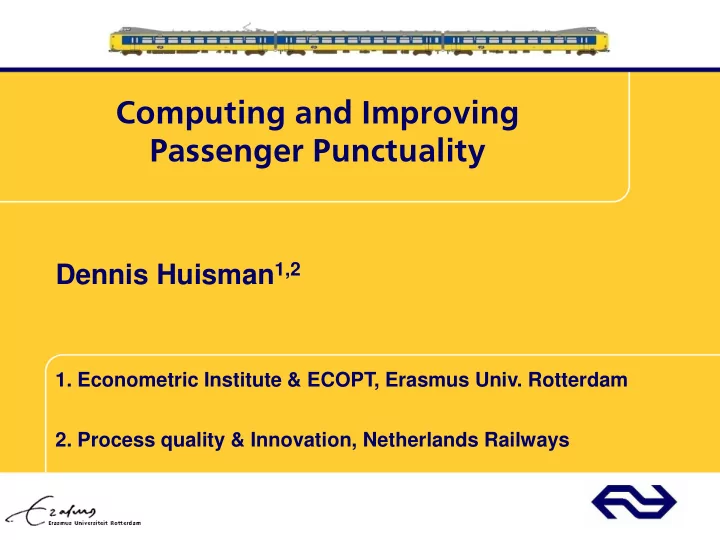

Computing and Improving Passenger Punctuality Dennis Huisman 1,2 1. Econometric Institute & ECOPT, Erasmus Univ. Rotterdam 2. Process quality & Innovation, Netherlands Railways
Dutch Railway System Dense railway system Passenger trains (93%) Cyclic timetable (1 hr) NS operates the main lines until 2025 (85% of the passenger train km) >1 million passenger trips/day >17 billion passenger km/yr Infrastructure management and operations are split
Traditional definitions of (passenger) punctuality
Traditional definitions (1) • Train punctuality: percentage of arrivals which were on time compared to the planning. ProRail measures this indicator at 35 large stations. Cancelled trains and renumbered trains are not considered in this indicator. • Operated trains: percentage of trains which were actually operated (possibly renumbered) compared to the planning. • Note: Two major KPIs in the concession agreement 2005-2014
Traditional definitions (2) • Traditional passenger punctuality: weighted average of the train punctuality at 35 large stations. The weights are based on forecasted amount of passengers. Cancelled trains and some predefined transfers are taken into account as well. • Note: KPI since 2011 for NS next to train punctuality, major KPI in concession agreement 2015-2024 for NS and ProRail
New method to compute passenger punctuality
Passenger punctuality 2.0 • Passengers assume to arrive according to the advice from the travel planner, where they ask for a trip from station A to station B at a certain time • Passenger delay can be computed as the difference between the “actual” arrival time of the passenger and the expected arrival time according to the travel advice
Passenger punctuality 2.0 - Example Passenger punctuality 1.0 • Only 1 transfer taken into account (Rotterdam Centraal) disruption • Punctuality measured in Rotterdam Centraal, Gouda, Utrecht Centraal, Amersfoort & Zwolle. Passenger trip counts 5 times. • Passenger trip is “4/5 th successful” Passenger punctuality 2.0 • Both transfers taken into account (Rotterdam Centraal, Zwolle) • Punctuality is measured as trip from Rotterdam Zuid to Akkrum. Passenger trip only counts once. • Passenger trip is “not successful” +10
Improving missed connections (Delay Management)
Delay Management • To improve the reliability of the connections, the operator can decide to delay connecting trains slightly in case of a delayed feeder train. • Delay management decides which connections to drop and which to maintain. • With good delay management, one can have short connections that are reliable at the same time!
Delay Management - definition Given • a planned timetable, • a set of source delays, • the passengers’ travel plans determine • a new timetable, • and new travel plans for the passengers, such that the total delay for the passengers is as small as possible.
Modeling the passenger delay • The main difficulty in modeling the delay management problem, is to determine the delay for the passengers. • If all connections for a passengers are maintained, this delay equals the delay of the last train. • If a passenger misses a connection, the travel plan for that passenger has to be adjusted. The delay will depend on this new travel plan.
Classical Delay Management • Schöbel (2001, 2006) gave an integer programming formulation for the Delay Management Problem. • If a passenger misses a connection, he will wait for the next train that departs one cycle time later. • The delay equals • the delay of the last train if all connections on the path are maintained; • exactly one cycle time if a connection is dropped.
Delay Management with Rerouting • Dollevoet, Huisman, Schmidt and Schöbel (2012) introduced the concept of passenger rerouting. • We determine a route through the railway network for each OD pair explicitly by assuming that the passengers select the fastest path to their destination.
Example wait-depart decision Den Bosch (1)
Example wait-depart decision Den Bosch (2)
Example wait-depart decision Den Bosch (3) • Applying optimal wait-depart decisions would result in 30% less passenger delays then having no waiting time rule at all
Disadvantages of this approach 1. Complex mathematical model resulting in too high computation times for real-time rescheduling 2. For every situation a different decision This led to the question if with simple rules-of-thumb a near-optimal solution can be achieved? • Master thesis Nicole de Lugt (2013) • Develop rules-of-thumb for wait-depart decisions
Simple rules-of-thumb • In this example, 2 intervals results based on the median value in a solution of less than 1% from the optimal solution
To summarize … • Passenger punctuality can be measured accurately via smartcard data • Passenger punctuality will be very important in the coming years • Passenger punctuality can be improved by less delayed trains, less cancelled train and less missed connections • For the latter, exact delay management models or rules-of-thumb derived from these models could be used Put Passengers First!
Recommend
More recommend